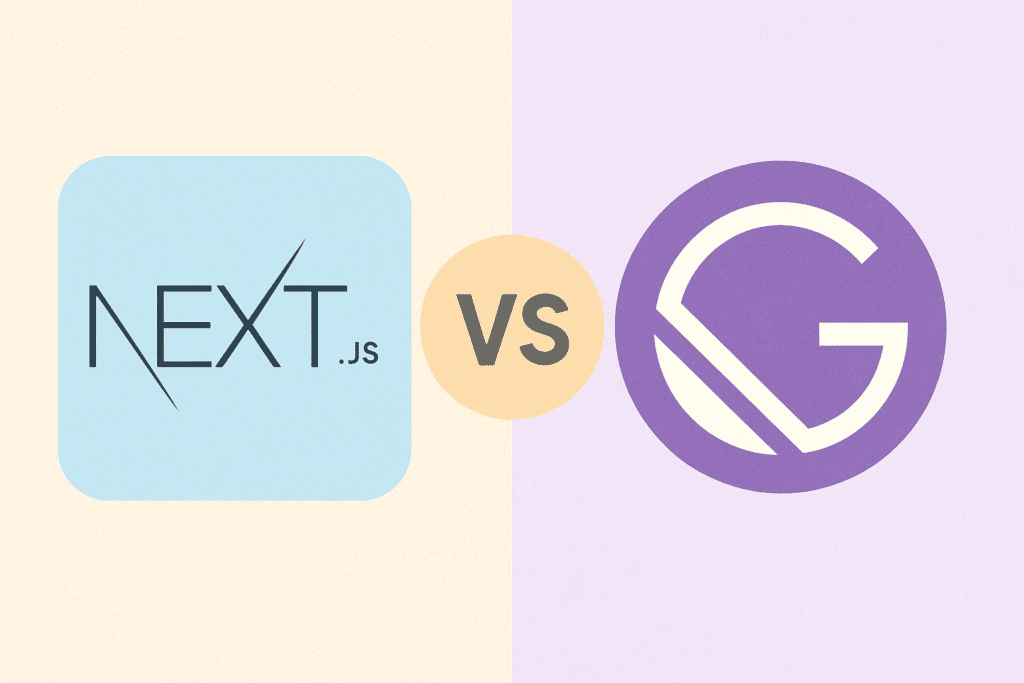When it comes to building fast, scalable, and SEO-friendly static websites, two frameworks dominate the modern web development scene: Next.js and Gatsby. Both are built on top of React.js and offer developers powerful features to create lightning-fast static sites and web apps. However, each has its own strengths and weaknesses that make them suitable for different use cases.
In this detailed comparison, we’ll explore Next.js vs Gatsby from multiple aspects—such as performance, development experience, scalability, SEO, and more—to help you decide which one fits your project best.

1. Overview of Next.js
Next.js, developed by Vercel, is a hybrid React framework that supports static site generation (SSG), server-side rendering (SSR), and client-side rendering (CSR). This flexibility allows developers to create both static websites and dynamic applications using the same codebase.
Next.js makes it incredibly easy to build modern web applications with features like automatic code splitting, API routes, and image optimization. Its incremental static regeneration (ISR) allows developers to update static pages after deployment without rebuilding the entire site.
Main Features of Next.js:
- Supports Static Site Generation (SSG) and Server-Side Rendering (SSR)
- Incremental Static Regeneration (ISR)
- Dynamic routing with file-based structure
- Built-in API routes for backend logic
- Excellent performance and SEO optimization
2. Overview of Gatsby
Gatsby is a React-based static site generator designed primarily for building blazing-fast websites with content sourced from APIs, CMS, and local files. It relies on a GraphQL data layer that allows developers to fetch data from multiple sources in a unified way.
Gatsby is known for its extensive plugin ecosystem, which simplifies integrations with tools like WordPress, Contentful, and Shopify. It’s a great choice for content-heavy sites, blogs, and marketing websites that benefit from static content generation.
Main Features of Gatsby:
- Static Site Generation (SSG) with GraphQL
- Large ecosystem of plugins and starters
- Optimized images and asset loading
- Prefetching and lazy loading for better performance
- Strong community support
3. Next.js vs Gatsby: Detailed Comparison
| Feature | Next.js | Gatsby |
|---|---|---|
| Rendering Type | SSG, SSR, ISR, and CSR | SSG (Static Site Generation only) |
| Data Handling | Flexible API routes and on-demand fetching | Uses GraphQL for structured data queries |
| Build Time | Faster builds, supports incremental updates | Can be slow for large sites due to full rebuilds |
| Plugin Ecosystem | Smaller but growing number of integrations | Extensive plugin ecosystem |
| Learning Curve | Moderate, similar to React | Steeper due to GraphQL and configuration setup |
| Performance | High performance with dynamic capabilities | Excellent for static performance |
| SEO Optimization | Excellent (SSR + SSG) | Excellent (Static HTML + optimized assets) |
| Best Use Case | Dynamic websites, eCommerce, dashboards | Static blogs, documentation, marketing sites |
4. Performance and Scalability
Performance is a critical factor for static sites. Both frameworks deliver exceptional speed, but they approach scalability differently. Next.js can render pages on demand using ISR, meaning you don’t have to rebuild the whole site for minor content updates. This makes it ideal for large-scale websites.
On the other hand, Gatsby pre-builds every page during deployment, which can cause long build times on massive sites. However, Gatsby’s caching and incremental builds have improved significantly in recent versions.
5. SEO and Optimization
Both Next.js and Gatsby are SEO-friendly. Next.js offers SSR and SSG to ensure search engines can crawl fully rendered pages. Gatsby delivers static HTML files by default, which also enhances SEO performance. Additionally, both support meta tags, structured data, and Open Graph for social sharing.
For further optimization, developers can integrate advanced SEO tools like Yoast SEO or other meta management libraries.
6. Developer Experience
Next.js provides a simpler setup and better flexibility with API routes, making it suitable for full-stack developers. Its minimal configuration and integration with Vercel make deployment extremely fast.
Gatsby, while more complex initially, provides a strong ecosystem of templates and plugins that reduce repetitive tasks. Developers building content-rich sites with CMS backends often find Gatsby’s GraphQL data layer very powerful.
7. Community and Ecosystem
Next.js has rapidly grown thanks to Vercel’s active development and the framework’s integration with enterprise-level solutions. Gatsby also maintains a strong community, supported by numerous plugins and third-party integrations.
8. Which One Should You Choose?
The right choice depends on your project type:
- Choose Next.js if you need dynamic features, hybrid rendering (SSR + SSG), or plan to build large web applications with API integrations.
- Choose Gatsby if your site is mostly static, like blogs, portfolios, or documentation, and you prefer using a CMS with ready plugins.
9. Final Thoughts
Both Next.js and Gatsby are excellent frameworks for static sites, but they cater to slightly different audiences. Next.js shines with flexibility and scalability, while Gatsby excels in static performance and plugin richness. Understanding your project goals, content type, and long-term maintenance needs will help you choose the right framework.
In 2025 and beyond, Next.js is likely to dominate large-scale web projects due to its hybrid capabilities, while Gatsby remains a top choice for lightweight static websites that demand high speed and simplicity.

